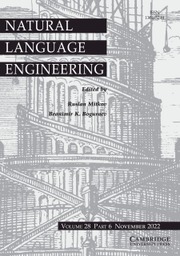No CrossRef data available.
Article contents
Between finite state and Prolog: constraint-based automata for efficient recognition of phrases
Published online by Cambridge University Press: 01 December 1996
Abstract
In computational linguistics, efficient recognition of phrases is an important prerequisite for many ambitious goals, such as automated extraction of terminology, part of speech disambiguation, and automated translation. If one wants to recognize a certain well-defined set of phrases, the question of which type of computational device to use for this task arises. For sets of phrases that are not too complex, as well as for many subtasks of the recognition process, finite state methods are appropriate and favourable because of their efficiency Gross and Perrin 1989; Silberztein 1993; Tapanainen 1995. However, if very large sets of possibly complex phrases are considered where correct resolution of grammatical structure requires morphological analysis (e.g. verb argument structure, extraposition of relative clauses, etc.), then the design and implementation of an appropriate finite state automaton might turn out to be infeasible in practice due to the immense number of morphological variants to be captured.
Information
- Type
- Research Article
- Information
- Copyright
- 1997 Cambridge University Press

